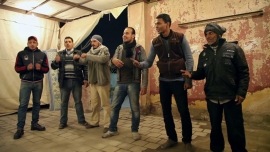"If I think about the future of cinema as art, I shiver" (Y. Ozu, 1959)
Out on the Street ( Jasmina Metwaly and Philip Rizk)
Tuesday, 27 October 2015 15:05Tout va bien in Egypt
Lulu Shamiyya
I get to watch Jasmina Metwaly and Philip Rizk’s Out on the street (Barra fel shari', 2015) in a post-revolutionary summer in Cairo. Tahrir Square is few miles away. I can just imagine the sound of the silence coming from down there: the silence of the everyday life that seems to be back on track. Today, out on the streets of Cairo there’s nothing than just the usual chaos of a megalopolis’ daily routine emptied from the imprévu once brought by a different kind of chaos, that of the revolution. Yet Out on the street reminds me that things never sleep in Cairo, not even the revolution.
A group of working-class men is invited on a Cairo rooftop to join an acting workshop aiming at staging a mise-en-scene of their factory and the power dynamics revolving around it. Police brutality, corruption, abuse of power, exploitation of the workers by their employers, threats of loosing jobs and being put out on the street: everything emerges during the rehearsals, everything is filmed by Metwaly and Rizk’s discreet camera. Quite soon the space of fiction given to the workers to recreate their daily struggle turns into a real space. Once being understood, the mechanism of exploitation is replicated and reproduced by the workers on other workers, as if it were the most natural thing: the mise-en-scene of the abuse becoming the abuse itself. Like in the hall of mirrors, exploitation is exercised from capital on the worker, and from the worker on another worker, and then on another worker, too. The filmmaker is there to witness and document, but has also to join the struggle.
This reminds of another factory, another time, another class struggle. France, 1972: Jean-Luc Godard and Jean-Pierre Gorin had just filmed Tout va bien, a caustic account of a strike at a sausage factory. At the time, Godard said in an interview1 that he was interested in looking at the social forces simultaneously at work in the same physical space: capital, the working-class, but also the leftists, the engaged intellectuals. One of Godard and Gorin’s main focus in Tout va bien was, in fact, the role of themselves as filmmakers in narrating the workers’ struggle and finding ways to support it. That is why Tout va bien is not so much a film about a workers’ rebellion against capital; rather, it documents the efforts of two engaged intellectuals in approaching this very struggle through cinema. How do we turn a revolution into a filmed image, into a spoken word, without having that same image, that very word betraying the revolution itself? How can a representation not violate the thing represented?
In the aftermath of the 2011 uprising, Metwaly and Rizk, who are members of the media collective Mosireen, raise this question again by asking the Egyptian workers to be their own metteurs en scene. Visually the film mixes together different sources of material (fictional performances taken from the acting workshop, interviews with the workers, personal mobile footage shot by a former factory employee). But what really blurs the line between factual and fictional, between the representation and the thing represented is the workers’ own mise-en-scene of their working condition, of the exploitation they are exposed to which they unconsciously get to replicate. Godard’s words in 1970s France resonate in 2010s Egypt: “the very medium we use was, up until now, in the hands of those we're fighting right against. Therefore, despite our good intentions, we don't completely control it”.
There were millions of cameras switched on the Egyptian revolution in 2011. The medium was in the hands of the people: yet, who controls the images of the revolution once they are generated? Who keeps them, preserves them, and makes use of them?
“Who directs today in France, who is the metteur en-scene” asked Godard in 1972.
“How dare we trade in images of resistance” asks Mosireen in Egypt 2011.
The charm of Metwaly and Rizk’s film lies in the question it raises about their own role as activists and filmmakers. It is as if they could not decide whether being with the workers and supporting the latter’s mise-en-scene to create a narrative of their oppression in order to counter-act the will of the exploiters to put them out on the street again, jobless and without dignity. Yet, at the same time, we feel that they would rather, as filmmakers and activists, be themselves out on the street, looking for the right image, for the right to the image. The one image that would not generate a cycle of “an industry of empathy”2, compassion, pity, solidarity with the revolution; but would, instead, drag more bodies out in the street.
2 Mosireen, Revolution Tryptich, p. 48 in "Uncommon Grounds: New Media and Critical Practice in the Middle Est and North Africa" edited by Anthony Downey, I.B. Tauris 2014
Ultimi articoli pubblicati
- 2025-03-24 Chime/Cloud/Serpent’s Path (Kurosawa Kiyoshi)
- 2025-03-24 Abiding Nowhere (Tsai Ming-liang)
- 2025-03-24 The Box Man (Gakuryū Ishii)
- 2025-03-24 Grand Tour (Miguel Gomes)


